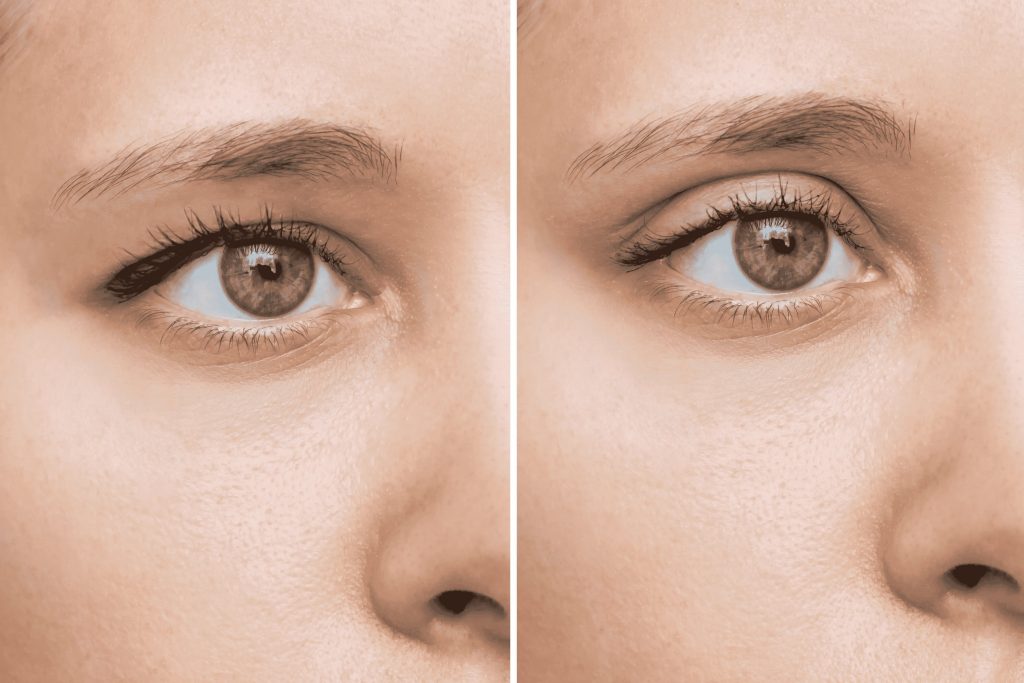Just had eyelid surgery and can’t wait to see the results? At Northern Beaches Cosmetic Surgery, we know eyelid surgery recovery can be tough. But don’t worry—there are easy things you can do to speed up your healing. Here are some helpful tips to get you looking and feeling great again in no time.
9 Tips for Optimal Eyelid Surgery Recovery
Eyelid surgery, or blepharoplasty, can enhance facial aesthetics and improve vision by removing excess skin, muscle, and sometimes fat from the eyelids. The recovery period is crucial to achieving the best results. Here are nine tips to aid your recovery:
Get Ready for a Smooth Recovery
Recovering from eyelid surgery usually takes about 10-14 days. To make this time easier, plan ahead. Clear your schedule and tackle your tasks before your surgery.
Think about stocking up on easy-to-make meals or arranging for someone to help with daily chores. This way, you can focus on resting and healing without extra stress.
Stick to Your Self-Care Routine
After your eyelid surgery, following your self-care plan is crucial. Before your procedure, chat with the team at Northern Beaches Cosmetic Surgery to understand what you’ll need for a smooth recovery.
Have items like cold compresses, eye drops, and ointments ready at home. These help with swelling and keep your eyes comfortable. It’s also good to have sterile gauze on hand for any minor oozing. Just dab gently if needed—no rubbing!
Protect Your Eyes from the Sun
Sun protection is important after eyelid surgery. We recommend shielding your eyes from sunlight and harsh elements.
Always wear dark sunglasses that cover your eyes from the sides. A hat can provide extra shade and help keep your eyes protected. Don’t forget to use sunscreen as directed in your post-surgery care plan.
Keeping your eyes safe from the sun speeds up your recovery and ensures the best results.
Stay Focused on the End Result
Your eyelids might look a bit swollen and bruised right after surgery. This is completely normal, but it can be tough to see past the initial appearance. At Northern Beaches Cosmetic Surgery, we want you to keep your eyes on the prize.

Remember, the swelling and bruising will subside within a couple of weeks. Soon, you’ll notice a fantastic change: younger-looking eyes and a refreshed appearance. Stay positive—the best is yet to come!
Avoid Straining Your Eyes
After eyelid surgery, it’s best to give your eyes a break. We suggest steering clear of activities that can stress your eyes, like reading, staring at screens, or watching TV for long periods.
These activities can lead to dry eyes, which can slow down your recovery. Instead, take it easy and let your eyes rest. This will help you heal faster and more comfortably.
Rest is Key to Healing
Rest is absolutely vital after eyelid surgery. At Northern Beaches Cosmetic Surgery, we emphasise the importance of both your body and eyes getting plenty of sleep to heal properly. Recovery requires a lot of energy, and it’s normal to feel more tired than usual.
Be sure to allow yourself plenty of time to rest, including taking naps during the day. It’s important not to overdo it; avoid any strenuous activities that could tire you out further. The more you rest, the quicker your body can heal.
Remember, taking it easy is not just a recommendation—it’s a key part of your recovery process. By giving yourself this time to rest, you are helping to ensure a smoother and faster recovery.
Make Relaxation a Priority
To help your eyelids heal quickly, keeping your recovery relaxed is key. We recommend avoiding stress by taking a break from work and focusing on calming activities.
Try to find enjoyable ways to pass the time that don’t strain your eyes. Consider listening to music, exploring new audiobooks, or simply resting. This approach will help you stay calm and aid in a faster recovery.
Avoid Heavy Workouts and Strenuous Activities
After eyelid surgery, it’s crucial to skip intense activities. We advise steering clear of exercises that boost blood flow to your eyes, like running, lifting weights, or participating in sports.
Also, be cautious with everyday actions that might increase pressure in your head, such as bending over or carrying heavy objects. Giving your eyes a break from these activities will help you heal faster.
Quit Smoking for a Faster Recovery
Smoking can really slow down your healing process. At Northern Beaches Cosmetic Surgery, we advise stopping smoking at least six weeks before your eyelid surgery to help your recovery go more smoothly.
By quitting smoking, you’ll reduce your risk of complications and infections, speeding up your recovery time. If you have any concerns during your recovery, don’t hesitate to reach out to our team for support.
Monitoring Your Progress: What to Expect Week by Week
Recovering from eyelid surgery, or blepharoplasty, is a gradual process that varies slightly for each individual. However, there are common milestones that most patients can expect as they navigate through the weeks following the procedure.
Here’s a detailed week-by-week guide to help you understand and monitor your recovery progress.
Week 1: Initial Recovery Phase
Days 1-3
The first few days after surgery are crucial. You will likely experience swelling and bruising around the eyes, and this is the peak period for these symptoms. It’s important to rest your eyes and keep your head elevated to help reduce swelling.
Applying cold compresses can also be beneficial during this stage. Pain medication prescribed by your surgeon can help manage any discomfort.
Day 4-7
Towards the end of the first week, you may start noticing a decrease in swelling and bruising. Although your vision might still be blurry, it should begin to improve. It’s essential to continue resting and avoid any activities that could strain your eyes, such as reading, using computers, or watching television for extended periods.
Week 2: Continued Healing and Reduced Swelling
Days 8-14
In the second week, you will see a significant reduction in swelling and bruising. The stitches, if non-absorbable, are typically removed during this period. You might feel more comfortable, but it’s important to continue protecting your eyes from sunlight and harsh winds.
Wearing sunglasses when outdoors is crucial. By the end of the second week, you can usually return to work and some normal activities, provided they are not too strenuous.
Week 3-4: Noticeable Improvements and Follow-up
Days 15-28
By the third week, you should see considerable improvement in the appearance of your eyelids. Swelling should subside enough for you to begin appreciating the results of your surgery. However, some residual swelling may persist for a few more weeks.
It’s important to have a follow-up appointment with your surgeon during this time to ensure that your recovery is on track and there are no complications. Light exercise like walking can be resumed, but keep avoiding vigorous activities.
Week 5-6: Gradual Return to Normalcy
Days 29-42
During this phase, you should feel almost back to normal. Any residual swelling or bruising should continue to diminish. You can start engaging in more vigorous physical activities, but it’s wise to get approval from your surgeon before resuming anything too strenuous.
It’s also a good time to start gently applying makeup again, provided you do not experience any irritation.
Week 7-8: Full Recovery and Final Results
Days 43-56
By now, most, if not all, of the swelling and bruising should have resolved. Your eyelids are likely to look more natural, and the final results of your surgery should be visible. The incision lines will continue to fade over the next several months. You should follow up with your surgeon to discuss the outcome and any further steps if necessary.
Long-Term Care
Beyond Week 8
While the major healing is typically completed by the eighth week, it’s crucial to continue caring for your eyelids to maintain the results of your surgery.
Regular use of sunscreen, maintaining a healthy lifestyle, and adhering to a skincare routine are essential to support the longevity of your results. Annual check-ups with your surgeon can help address any long-term changes or concerns.
When to Seek Help: Recognising Signs of Complications
Eyelid surgery, while generally safe, carries the potential for complications as does any surgical procedure. Recognising the signs that indicate complications early can be crucial in addressing them promptly and preventing more serious outcomes.
Here are key symptoms that should prompt you to seek immediate medical attention after eyelid surgery.
Persistent Pain
While some discomfort is normal after eyelid surgery, persistent or severe pain that does not subside with prescribed painkillers is a cause for concern. This type of pain may be a sign of an infection or other complications that require a doctor’s intervention.
Increased Swelling or Bruising
Some swelling and bruising are expected after eyelid surgery, typically peaking within the first 48 hours before gradually improving. However, if you notice the swelling or bruising worsening after it has initially started to improve, or if it spreads to other areas such as the cheek or lower face, this could indicate a haemorrhage or other issues.

Changes in Vision
Any significant changes in vision following eyelid surgery, such as persistent blurriness, double vision, or loss of eyesight, should be treated as a medical emergency. While slight temporary blurring can be normal due to ointments or residual swelling, marked changes in vision are not and require immediate assessment by a professional.
Signs of Infection
Infections are rare but serious complications that can occur after any surgery. Symptoms of an infection may include increased redness around the incision sites, unusual discharge (which might be yellowish or greenish in colour), a foul odour, and fever. If you suspect an infection, it is imperative to contact your surgeon right away.
Unusual Skin Sensations
While numbness around the surgical site can occur and usually diminishes as the healing process progresses, the presence of new or increasing tingling sensations or actual pain when touching the area can indicate nerve damage or complications in the healing of the skin.
Difficulty with Eyelid Movements
Difficulty opening or closing your eyes, or noticeable asymmetry in eyelid position that worsens or does not improve, could suggest complications related to the muscles or nerves of the eyelids. This situation might require corrective procedures if it persists.
Emotional and Behavioural Changes
Do not underestimate the emotional impact of recovery. Feelings of distress, anxiety, or depression during the recovery process can also be a signal that you need additional support, possibly indicating that the physical symptoms are more severe than perceived.
People Also Ask
Can I wear makeup after eyelid surgery?
It’s best not to wear makeup around your eyes for at least two weeks after surgery to avoid infection and help your eyes heal properly.
What are the common side effects after blepharoplasty?
You might experience swelling, bruising, and some discomfort. These are normal and usually go away within a few weeks, but if they get worse, see your surgeon.
When can I get back to normal activities after eyelid surgery?
You can usually return to light activities and work in a week or two. Just make sure to follow your surgeon’s advice and avoid intense activities until you’re fully healed.
Your Path to a Swift Eyelid Surgery Recovery
Recovering from eyelid surgery doesn’t have to be a challenge. With a bit of preparation and the right approach, you can ensure a smoother, quicker recovery. By following these simple tips, you’ll be back to looking and feeling your best in no time.
For any questions or extra support during your eyelid surgery recovery, don’t hesitate to reach out to us. We’re here to help you every step of the way. Contact Northern Beaches Cosmetic Surgery today to ensure your recovery is as smooth as possible.

